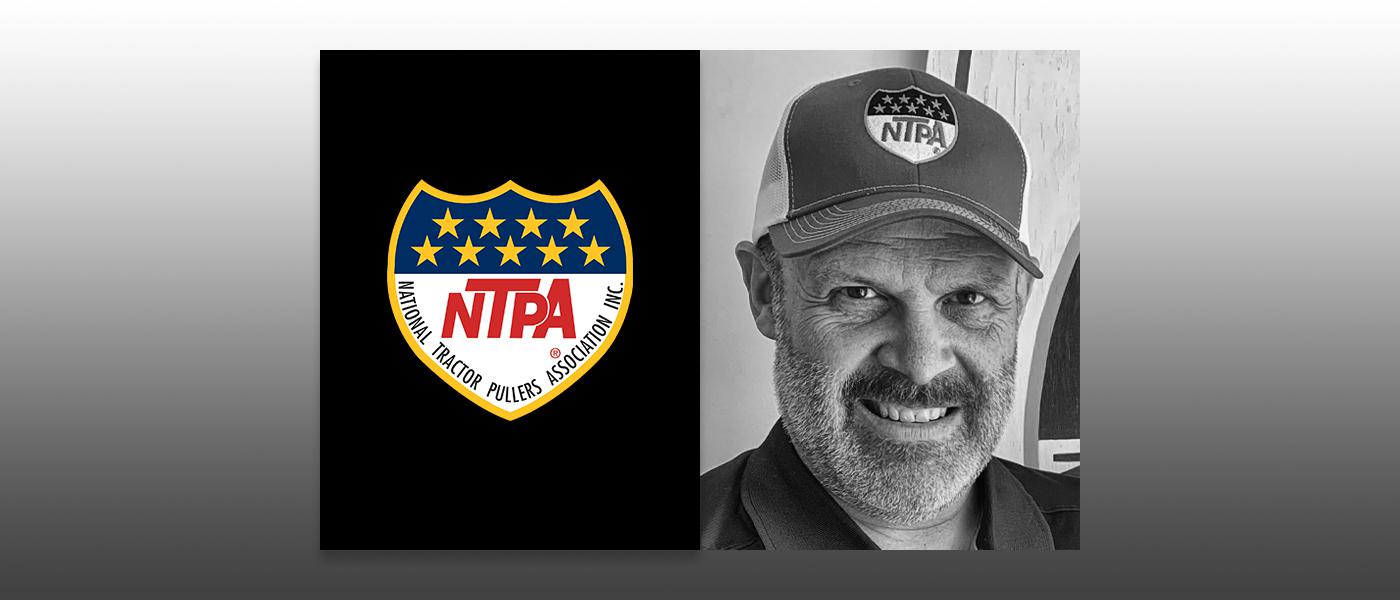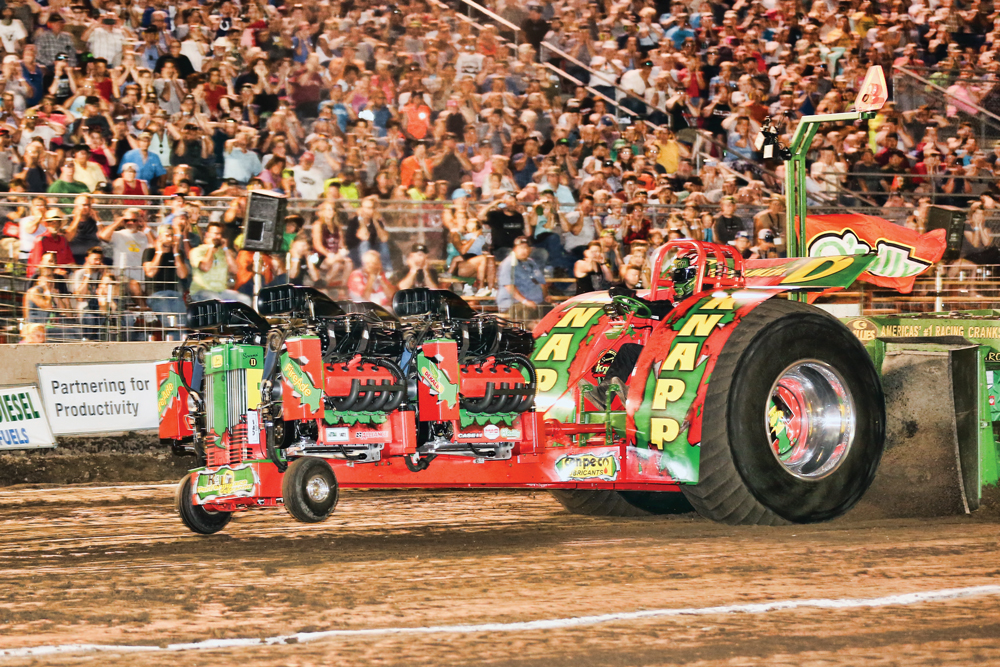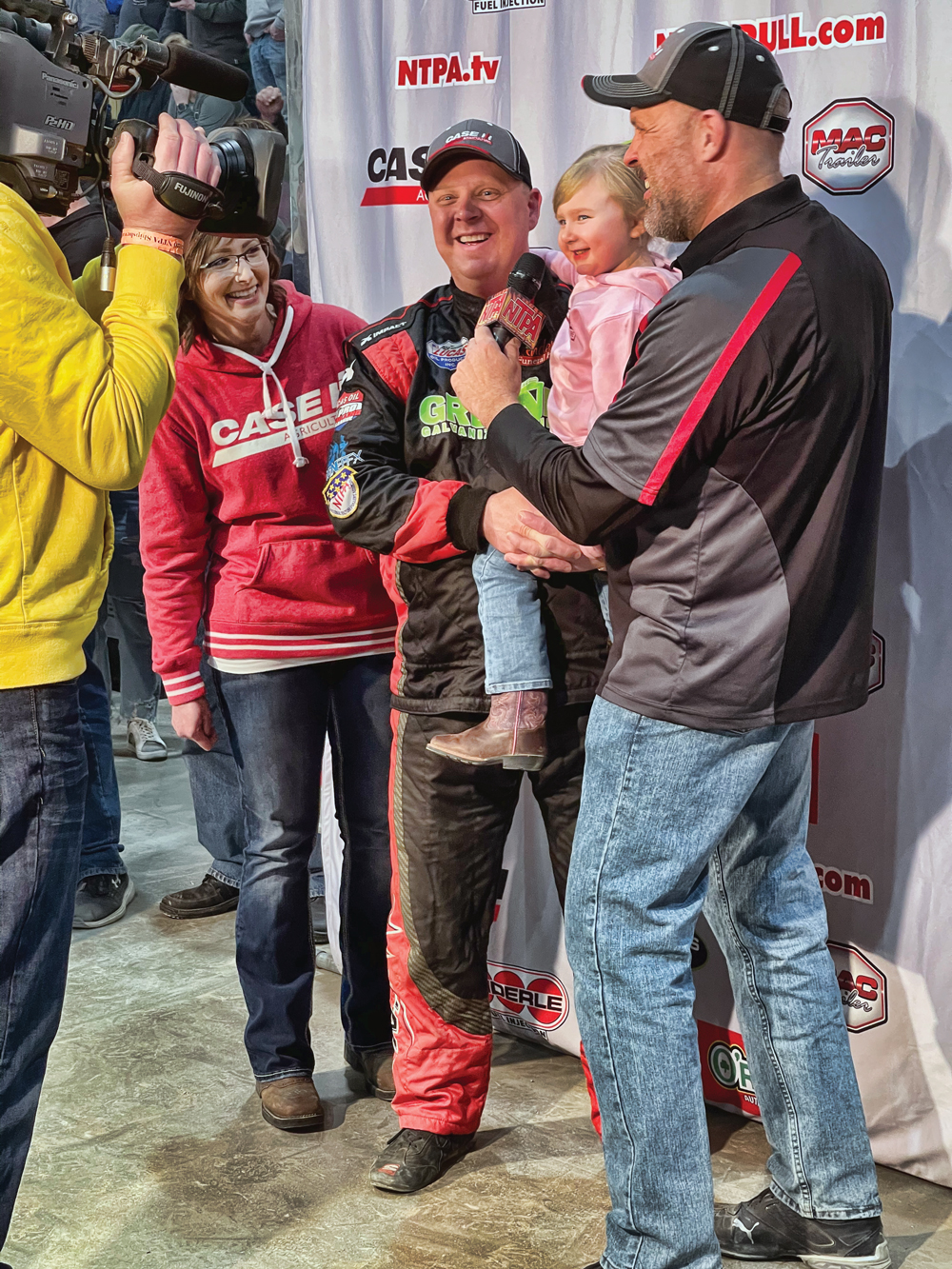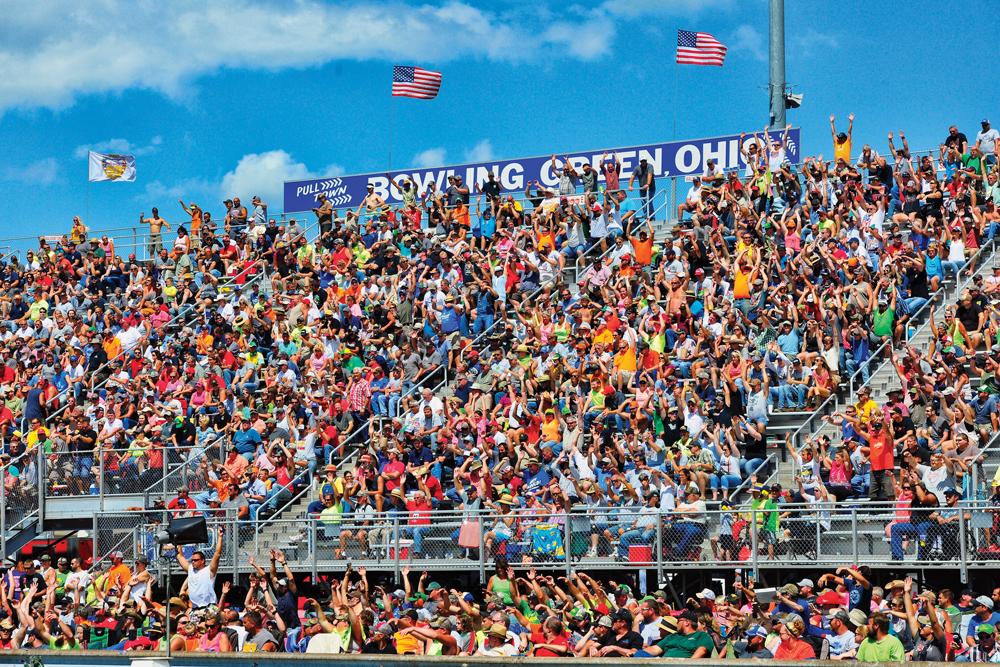Industry Insights: Gregg Randall

Truck and tractor pulling remains wildly popular among fans and racers alike thanks to cutting-edge engine technology, reliable safety standards, and its all-American, grassroots atmosphere, according to one of the sport’s most knowledgeable and longest-serving officials.
People come and go in the business world, particularly in leadership positions. But it’s quite the opposite with Gregg Randall, the executive director of the National Tractor Pullers Association (NTPA). Randall joined NTPA 31 years ago as a scoreboard operator immediately following his college graduation, and aside from a brief stint away to assist with a family business, Randall today leads NTPA from its headquarters in Worthington, Ohio.
Pulling is a historic sport that predates the piston engine. In modern times the sport has become a fan favorite, with deep roots in rural and small-town America. The concept of harnessing modern horsepower to move a giant weighted sled down a track continues to attract hordes of fans both in person and on television.
Like all modern sports, NTPA today must navigate through numerous contemporary challenges. It has capitalized on the hometown appeal of the sport and continues to reach fans in a variety of ways. NTPA’s longtime relationship with RFD-TV is one of the most enduring in motorsports, and its “NTPA Championship Pulling” television program is a perennial viewer favorite.
An Ohio native and a graduate of Urbana University, Randall recently visited with Industry Insights to reflect upon the current state of pulling and his lifetime of involvement in the sport.
PRI: Tractor and truck pulling is a very unique form of motorsports, and fans and competitors tend to be passionate and loyal. What is it about the sport that creates such passion?
Randall: I think there are a couple of secrets to our success. One of them is the engineering marvel of multi-engine tractors and combinations. Two, three, four, five engines together, that has proven to hold a very popular appeal. Second, I think our accessibility to fans is a key. Our fans can roam the pit area freely and see the equipment and drivers up close. Our drivers are very engaging, and that’s a refreshing thing for fans. I’ve visited different types of sanctioned events in motorsports, not only motorsports but professional sports, and their accessibility is very limited and very structured. That’s a factor in keeping our sport popular with fans.
For instance, this weekend we are going to Atwood, Tennessee, and it’s our first time down there. Many times when we go somewhere new, the promoter will ask about accessibility. We’re going to a race track, so they are used to the concept of a hot pit area being from the gate of the pit area throughout the race course. We’re different; we’re like drag racing, where everybody can roam around. Our hot pit actually starts near the competition area and ends at the end of the competition area. So our cold pits are quite large compared to other forms of motorsports.
PRI: Technology continues to shape every form of motorsports today. Electronics, digital tools, and so forth. How about pulling? Has technology in the vehicles impacted the sport?
Randall: It has. As you said, every form of motorsports has been impacted. The biggest thing we see is the use of the dyno. It used to be that a dyno was a luxury; now it is a necessity. With turbocharging in particular, that’s where we’ve seen a lot of gains and a lot of things being figured out. You go back to the sport 40 years ago; they were literally hooking to the sled to test stuff. There was no other method to see how something would perform aside from in competition. Now the dyno is a big piece to tune all that horsepower.
It’s very interesting; you take an off-season like we’ve had due to the pandemic, and what do guys do with their time? I think a lot of them spent time at the dyno. So now we come out on the track and here’s a guy who was a sixth- to eighth-place tractor consistently, now because of their work in the off-season they are a top-three tractor. Why? Because the money they saved from not running their tractor last year they spent this winter on the dyno, or with other technology.
PRI: Let’s talk about the competitors. Pulling has always been very grassroots, filled with independent people and teams. Is that still the culture within pulling?
Randall: That really is the culture. A lot of our competitors are business owners; we’ve got competitors who own huge manufacturing businesses. These people are independent, but they’re not necessarily sponsored and hired to go out. They are individual owners of businesses and their pulling operation. We’ve got some sponsorship in teams and that’s a great thing, a great bargain. It’s still a family-based sport where the kids will come along. Normally on our Grand National circuit the teams are taking a crew of one or more people who work on the vehicle and make sure it’s ready to go. That’s expanded a little bit over the years, I think. But we still have that appeal for independent-minded people, from grassroots America.
PRI: Does the grassroots nature of your competitors influence how you schedule events? Is there a geographic range you have to keep in mind?
Randall: I always joke about being in the Midwest, our circuit seems to primarily land in the [NCAA] Big Ten conference. We’re in Minnesota, Wisconsin, Illinois, Michigan, Ohio, Indiana. We have some events now in the southeast—Virginia and North Carolina, for example. And this year we’re going to Dodge City, Kansas, and we’re very excited about that [new] event. Craig and Julie Dollansky are the new managers at the facility there, and their event is the July 4th weekend. Behind my desk I have a map with stick pins for all of our Grand National events, and the Dodge City event definitely lands far west outside of our circle. But they really want to build this into a major event, and I think we will. They have the right attitude and promotion smarts to make it happen. We’ve got a lot of events where pulling kind of lands at ground zero of our base: Ohio and Indiana, for example. As we go farther out, we don’t have as many events, but we continue to expand outside the circle a little bit.

PRI: In agriculture, brand identity remains very strong. John Deere and Case IH, for example, each have their own loyal following. Is this something NTPA is able to capitalize on?
Randall: The brand loyalty is there, and it connects so well with the fans. And, of course, you’ve got the Chevy-Ford-Dodge [truck] rivalry as well. That hasn’t changed in my five decades of being around the sport. There are still some real die-hards within our sport who definitely cheer for the red [Case IH] or the green [John Deere]. It’s interesting, the presenting sponsor of our Grand National circuit is Case IH, and we’ve worked with them for several years now. It’s a great company to work with. They are definitely aware of that brand loyalty, and if you run the Grand National circuit you’ve got to have a Case IH sticker on your vehicle. It’s kind of funny to see the John Deere guys put the Case IH sticker on. Sometimes they’ll hear a little bit of razzing about it, but those competitors say, “Hey, they’re putting money into the sport, we support them and they support us, and that’s all good!”
But the rivalry is still there. We have our weekly television series, and I’m one of the hosts and do the winner’s circle interviews. It’s funny because we put a Case IH hat on the winner’s head, and the John Deere guys often say, “Hey, gimme that Case IH hat. That’s the only time you’ll see me wearing one, but I’m glad to put it on because I just won the event!” We have a lot of fun with that.
PRI: NTPA has had a long presence on television through your relationship with RFD-TV. Frankly, this is probably one of the most natural, ideal partnerships in all motorsports. How important has this traditional television outlet been in your growth over the past couple of decades?
Randall: Television has definitely been the stick that stirs the drink when it comes to attracting sponsorships. We have Case IH that I mentioned, O’Reilly Auto Parts, Hot Shot’s Secret, Angry Farmer products, and some others, and they connect with the rural market. That’s where our relationship with RFD has been really solid. It is unique, because it fits our demographics so perfectly.
The other thing that’s been so nice is that through all these years [our show has] been on Tuesday nights at 6:30 p.m. EST. Plus, our Monday morning at 12:30 a.m. EST [slot] is actually great for Pacific time. I’ve had many people from California mention they’ve watched us during that time slot. So it has been very good for us and has attracted sponsors. We’ve been with the [RFD] network for 17 years, and I think that’s probably an ongoing record in motorsports, staying on the same network for that many consecutive years.

PRI: NTPA is also actively marketing live streaming of events. What’s been your experience thus far with live streaming?
Randall: We’ve had some very good guys working with us in that area. The Steinmetz brothers [Matt and Josh] over the years have had a big impact on our streaming. It is a pay-per-view broadcast, and it has grown every year. I think this is our eighth year, maybe ninth. Almost 10 years. It’s the promoter’s event, and we don’t just take all the streaming revenue and put it in our pocket; the majority of that revenue goes back to our promoters. And it’s a product the fans enjoy. The crew people who are not able to attend the event, they enjoy tuning in. It’s funny, our first event of this year was at Sauk Rapids, Minnesota, and we did not have streaming available for the event. We immediately heard from several people, “Why aren’t you live streaming this event?” So we know the audience is there, and it’s been a positive product for us to serve more fans and promoters. It’s a win-win all the way around.

PRI: The concept of electric vehicles has clearly arrived in many forms of motorsports. What are your thoughts with regards to EVs? Have you seen any movement to try an electric entry in pulling?
Randall: I just had an inquiry from California about that very topic, asking if we had considered putting together a class of electric-powered vehicles. I explained that our promoters need a few vehicles in each class in order to be feasible, and I’m not sure how that would begin. We have categories and rules, and most of those are [based on] combustion-type engines. So it’s going to be interesting to see what the next few years bring. We’re a little bit behind on that, I know it’s in drag racing and other forms of motorsports. But it will be interesting.
PRI: You’re also involved as executive producer of your television property, “NTPA Championship Pulling.” How much of your time and energy goes into producing the show?
Randall: My role in the show mainly comes down to the contract with each of the venues we go to. We give the promoter an inventory of commercials for each show, and then we figure out what classes will be on the show. We try to balance all of our divisions and what we want to film.
There are things I’d like to see happen with our show. I’d like to see us expand to an hour-long show, to be honest with you. I think we could attract much more sponsorship with an hour-long show. And we could do more with the show itself. That’s a direction I’d like to see us go, but we haven’t quite got there yet.
PRI: Let’s talk about safety. What elements has NTPA implemented in recent years with an eye on keeping competitors and fans safe?
Randall: First and foremost, our involvement in the SFI program has been paramount to our success in the area of safety. Many years ago, we were the second or third sanctioning body to be involved with SFI. They pre-date my time with the company, in fact. That in itself keeps things fresh with all the moving parts of the combustion engine. We’ve also got a very good tech safety department, headed up in Brownsburg, Indiana, with Larry Richwine. Larry has a hundred-some officials who are trained through Larry and certified through SFI. That’s the number-one piece to our safety program. We need those people in place to make sure the SFI standards are being followed.
We’ve also talked about track length. For a long time, our track length was 300 feet, as wide as a two-lane highway and as long as a football field, end zone to end zone. Now we’re as long as a football field from the end line at the back of the end zone. We’re at a maximum of 350 feet at most venues because we need safe run-off zones with entrapments, sand zones, that sort of thing. A lot of it has to do with the fact that the vehicles are running so hard because of increased horsepower. It’s hard to keep the vehicles together, night after night, week after week, if you’re running a longer course. It makes it very difficult on the vehicles to have multiple runs on the same night, and it’s something we are looking into. The goal is to pull the sled farther than all of your competition, that’s a simple thing to understand. But what does that mean? What distance? That’s something that has changed a lot in the last 10 years.
PRI: PRI is more active than ever in leading the industry in terms of actively protecting ourselves from government and agency restrictions. Are there issues unique to pulling that could threaten the sport?
Randall: As we get back to normal after the pandemic, we have often said that we’re glad we are pulling in communities of 10,000 people or less. That’s normally where we are: fairs, those types of facilities. If we were pulling in the major cities, we would probably find a lot more of this type of scrutiny (social distancing). So is it on our radar? Yes, we’re aware of what goes on. But a lot of times that scrutiny is more active in larger cities. In smaller communities that scrutiny has not arrived yet. That’s kind of how we view the situation.
PRI: Your first tenure with NTPA came right out of college back in 1990. I’m probably stating the obvious when I say that pulling has been a lifetime passion for you.
Randall: Yes. I can remember going with my dad to the Ohio State Fair. they had one of the bigger pulls around, just an hour from our house. The engineering of the tractors, the big tires, as a kid it was fascinating. From there, I came to enjoy the competition.
I love all the divisions we have in our portfolio, because they all have unique challenges. But the goal is the same: to be the strongest of the night in that division. So yes, I’ve enjoyed pulling and I still enjoy the sport.
PRI: How has the sport changed since that time? What’s different than, say, 1990?
Randall: The speed of the vehicles going down the track. A lot of times our sled operators can tell what the top speed was going down the track based on experience, and usually if they aren’t going 33 to 34 mph at some point, it’s a surprise. It’s a combination of the track, maybe the sled isn’t set quite right, but you’ll hear people say, “Man, that was 37 miles an hour!” We haven’t publicized that issue very much, but that might come in the future. When you’re going that fast, with that amount of weight on your tail, that is really flying with that much weight. It would be interesting to take video from previous decades and sync up the video for 300 feet and see how much the pull speeds have increased. I guarantee that we’re going faster now than we did in previous years. If you look back 20 or 30 years, the difference has been dramatic.
PRI: We’ll close with this, Greg. What’s ahead for NTPA? What’s on the horizon that has you and your staff fired up?
Randall: I’ll be honest with you, that’s a tough question at the moment. We’re trying to feel our way through the newness of the post-pandemic world. We are definitely looking forward to getting back to a normal situation where crowds can gather and enjoy this all-American form of the sport. Quite honestly, we feel very blessed to be able to conduct these pulls. It’s still kind of a timeless thing. Going to a fairgrounds, you don’t often go to a fairgrounds to watch motorsports. There is still a history there, where my grandfather and my father, myself, and now my children and grandchildren, we’re going back to the same places. I can look back 50 years and look ahead 20 years. Will the same faces still be part of this form of motorsports? I think they will, and that’s one of the really unique things about our sport.
PRI: Gregg, we appreciate you sharing your time with us. Thank you, and all the best as you and your series work through the 2021 season.
Randall: Thank you, Dave. We appreciate your interest in NTPA.
 MEMBERSHIP LOGIN
MEMBERSHIP LOGIN JOIN PRI
JOIN PRI


